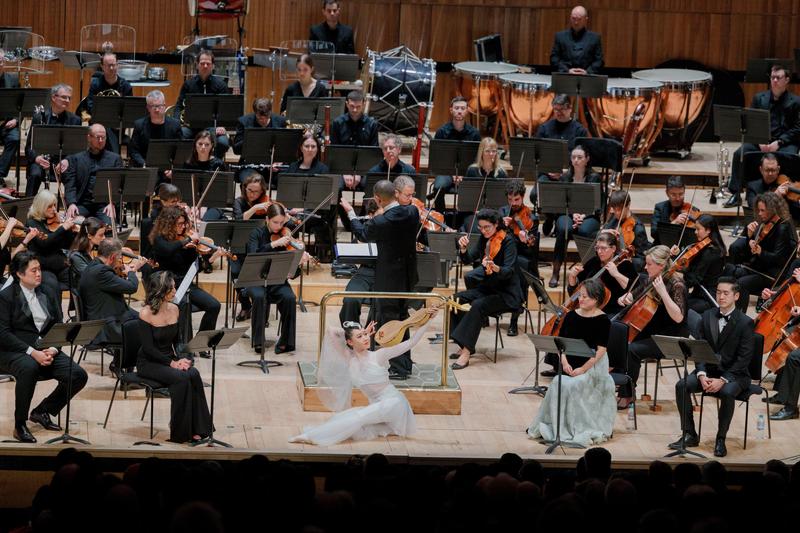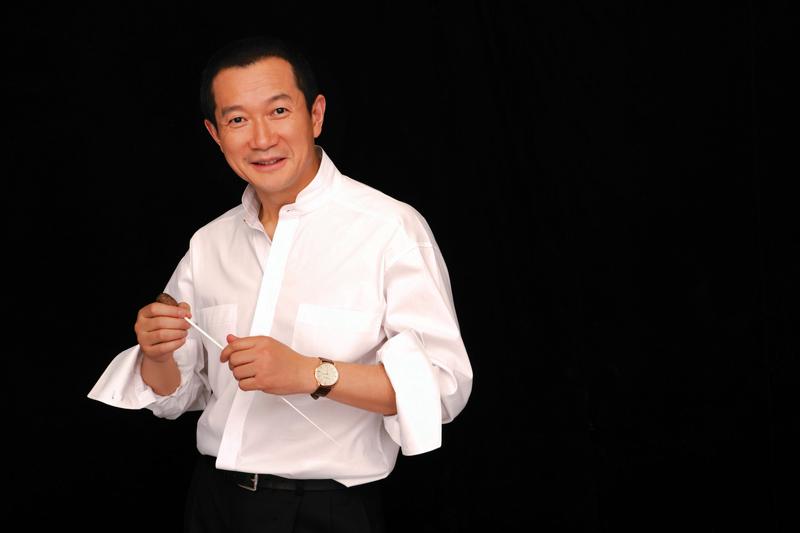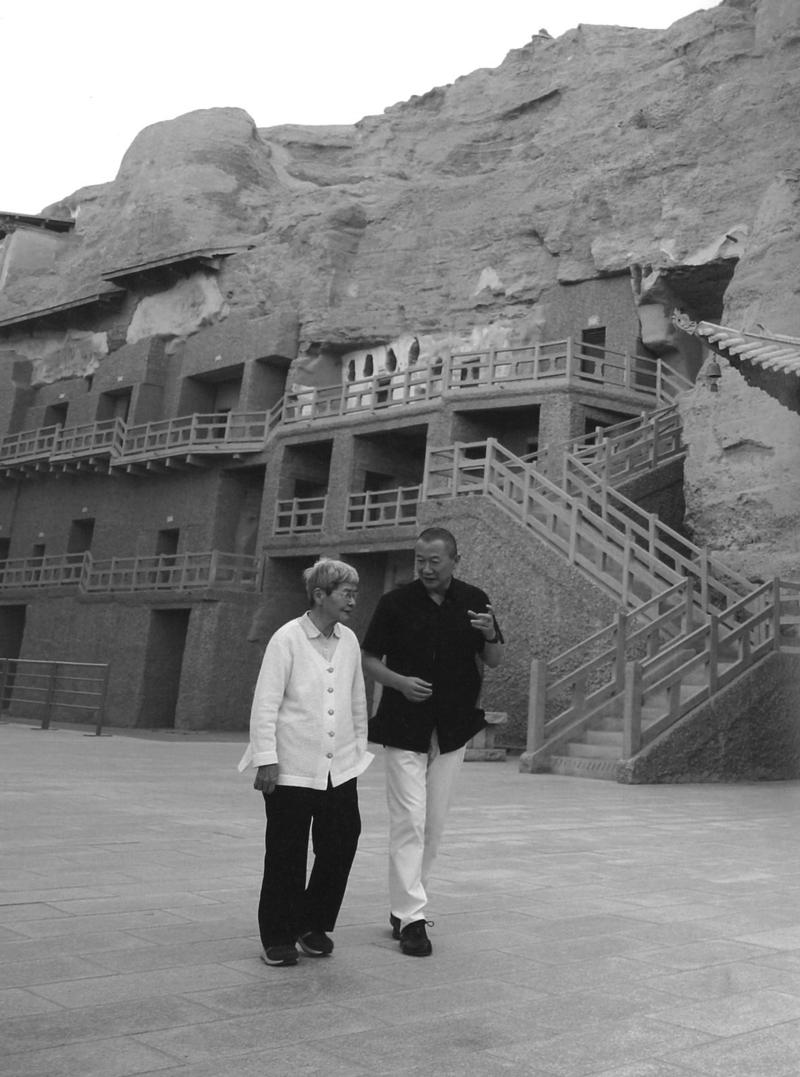Celebrated composer Tan Dun's symphonic composition, Buddha Passion, inspired by the ancient murals of Dunhuang, makes its British debut, Wang Linyan reports in London.
 Conductor Tan Dun, pipa dancer Chen Yining and the London Philharmonic Orchestra perform Buddha Passion on Jan 22. (PHOTO PROVIDED TO CHINA DAILY)
Conductor Tan Dun, pipa dancer Chen Yining and the London Philharmonic Orchestra perform Buddha Passion on Jan 22. (PHOTO PROVIDED TO CHINA DAILY)
Tan Dun still remembers the deep thrill he felt when he first set foot in the ancient Mogao Caves during a visit to Dunhuang in 2012.
The famed composer stayed in the caves for five hours, and thought it would be fascinating to transcribe the wonderful stories from the murals into music and perform them with a modern-day symphony orchestra.
As an artist, the most satisfying thing is not how many concerts you have done or how many tickets you sold. It’s how much you have managed to reach the heart and soul.
Tan Dun, composer
"Director of the Dunhuang Academy, Fan Jinshi, joked with me, 'Could you transform those paintings into music?'" recalls Tan, who received an Academy Award for his brilliant soundtrack in the film Crouching Tiger, Hidden Dragon.
"We can't carry those cave paintings around, but we can move an orchestra and musicians around to be a bridge that links the past and the future, carrying ancient culture, ancient China, to the world."
It took Tan six years to create Buddha Passion, which had its world premiere at the Dresden Music Festival in Germany in May 2018.
On Jan 22, Chinese Lunar New Year's Day, the London Philharmonic Orchestra performed the UK premiere of Buddha Passion, with five vocal soloists, a double choir and traditional instruments. The London Philharmonic Choir and the London Chinese Philharmonic Choir, which totaled 135 singers, were conducted by Tan. The performance won a longstanding ovation.
The creation
The piece of work comprises six acts, each describing an individual story from the mural paintings in the Mogao Caves in Dunhuang, an oasis in the Gobi Desert on the ancient Silk Road in northwestern China. For example, the second act tells the story of The Deer of Nine Colors, which was made into a Chinese animated film.
To produce the composition, Tan made 15 trips to the world heritage site, including his first one at the invitation of the Dunhuang Academy and some of his friends.
 Tan Dun, composer. (PHOTO PROVIDED TO CHINA DAILY)
Tan Dun, composer. (PHOTO PROVIDED TO CHINA DAILY)
More than 1,000 years old, Mogao Caves contain one of the world's largest collections of Buddhist art, with colored sculptures and murals decorating more than 700-plus cave temples carved into the cliffs. Music-themed murals there depict more than 4,000 musical instruments, 3,000 musicians and 500 orchestras, according to Tan.
"It's very difficult to select only six stories for six acts out of 4,000 paintings. Thousands of paintings are all about compassion, about love and about music," Tan says.
"Finally, I decided to select the paintings and music stories that reflect the whole life of Buddha. That's why I went there many, many times."
Two years were spent on researching ancient music manuscripts from the caves, after Tan learned that some of them are scattered around the world, with collections in the French National Library, the British Library and the Nara National Museum in Japan.
"I remember opening one of the manuscripts from the 10th century, and I heard the sound from 1,500 years ago. I was transported from my spot in London into the desert in ancient China and into these old stories," Tan explains, describing his experience at the British Library.
"It was a very artistic feeling," he says during a rehearsal break in London.
"As an artist, the most satisfying thing is not how many concerts you have done or how many tickets you sold. It's how much you have managed to reach the heart and soul.
"To transform the paintings and colors into the sound of music, that achievement as a composer is amazing. It's like a sportsman winning a championship. It's the same kind of experience."
Dance and instruments
To bring the music-themed murals of the Mogao Caves closer to the audience, Tan inserts a performance of Playing Pipa Reversed into the work.
An apsara (a fairy, or feitian in Chinese), dressed in white, dances along while playing a gourd pipa. The dance, which lasts about four minutes, demonstrates more than 20 poses from Tang-Dynasty (618-907) murals, according to Chen Yining, the dancer.
"The poses are from the murals, but the moves linking each pose are created in a way to make the audience feel like the apsara is flying out of the painting to perform in front of them, as requested by Mr Tan," Chen says.
The gourd pipa, which weighs 450 grams, has been grown and made to look exactly like the version in the murals.
Tan has even commissioned a replica of xiqin, an ancient two-stringed bowed instrument which he saw in one mural, specifically for Buddha Passion, with a specialist instrument maker.
To him, it's worthwhile. Making ancient instruments is "very hard and slow, but very unique", he says.
In addition to pipa and xiqin, Tan has also included elements of organic music, such as the sounds of singing bowls, water, bells and stones, in the symphony.
 Tan Dun talks with Fan Jinshi, a former director of the Dunhuang Academy, during a visit to the Mogao Caves. (PHOTO PROVIDED TO CHINA DAILY)
Tan Dun talks with Fan Jinshi, a former director of the Dunhuang Academy, during a visit to the Mogao Caves. (PHOTO PROVIDED TO CHINA DAILY)
The choirs
Emma Secher and Rylan Holey, both members of the London Philharmonic Choir, have been tasked to ring bells and play stones, respectively, with other members of the double choir at certain points during the performance.
"It's really amazing; he uses so many percussion techniques," says Secher.
"It's intelligent in terms of his music. It's quite often single track, but his round of music is magnificent," Holey adds. "It's very rare for us to sing with a living composer, to be conducted by someone who is so well-known, so well-regarded. His musical repertoire is astounding."
Both feel that it has been a challenge for the choir because they are not used to singing in Mandarin (with pronunciation marked in the script), but the fusion of Eastern and Western musical traditions works very well.
"It's a very accessible piece. I think it's going to really connect with people," Secher says before a rehearsal session.
Holey says that Tan inspired them to look at the murals in Dunhuang. "I would love to visit Mogao Caves to see all the context of the music, to see the murals and understand what it's all about."
The connection
This may be one of Tan's purposes for Buddha Passion, for it to be a bridge between the Mogao Caves and London, as well as other places in the world.
"I try to connect this ancient wisdom with the attitude of the future and am honored to bring my musical reflections to London and share my Buddha Passion," he says in a trailer on the London Philharmonic Orchestra's website.
"My goal to look back at the past is for the creation of the future," Tan explains. "So that's why you look at this orchestra, although it's a Western orchestra, it's actually reflecting the future.
"You have to understand that symphony orchestra is the only media in our human history that combines institutions, conservatories, art schools and academies of all kinds."
Tan says that symphony orchestra is no longer a Western genre; it's a medium of human history.
"It means it is a global system for sound. That's why I found it very important to write this work in symphonic form, to make every country talk about and share this interesting piece of music."
Contact the writer at wanglinyan@chinadaily.com.cn


